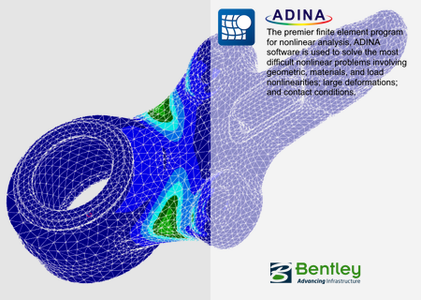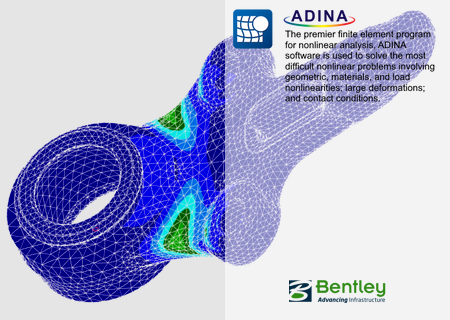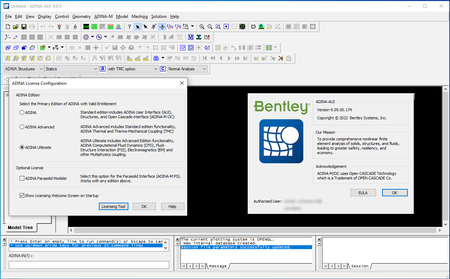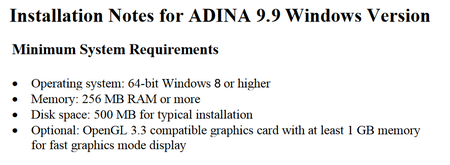ADINA CONNECT Edition V9 Update 9 | 759.2 mb
ADINA R & D Inc., a part Bentley Systems, team is pleased to announce the availability of ADINA CONNECT Edition V9 Update 9 (09.09.00.174) is powerful finite element software, built to help you solve the most difficult nonlinear problems involving geometric, material, and load nonlinearities; large deformations; and contact conditions.
ADINA 9.9.0 Release Notes - Date: October 2022
Version 9.9 is the first Bentley-built release of the ADINA System. The compilers and compilation options have been revised as part of the Bentley build procedure.
Changes in licensing
The ADINA User Interface and various solvers are now licensed through the Bentley Subscription Entitlement Service (SES), one of several CONNECT services common to all Bentley desktop applications.
The ADINA System is now licensed in three tiers or editions.
- ADINA Standard Edition authorizes use of the ADINA User Interface (ADINA AUI) and ADINA Structures. It also includes the ADINA-M Open CASCADE interface unless the ADINA Parasolid modeler option below is selected.
- ADINA Advanced includes all standard edition functionality as well as the ADINA Thermal (ADINA-T) and ADINA Thermo-Mechanical Coupling (ADINA-TMC) solutions.
- ADINA Ultimate includes all ADINA solver functionality. This includes, but is not limited to, ADINA Computational Fluid Dynamics (ADINA CFD), ADINA Fluid-Structure Interaction (ADINA FSI), ADINA Electromagnetics (ADINA EM) and other multi-physics coupling such as ADINA FSI/EM.
- ADINA Parasolid Modeler is an optional Parasolid modeling module for advanced solid modeling capabilities. This requires a separate license. The other CAD Interfaces are free with a current Bentley Systems subscription. This is activated through a license called Structural SELECT Entitlements.
All of the ADINA Editions and interfaces are installed with the single ADINA installer.
Changes in floating point round-off
Due to the changes in compilers and compiler options, the floating-point round-off is different in version 9.9. Therefore the results for sensitive problems may change between version 9.8.2 and version 9.9. Sensitive problems include problems with the following features:
- Static and implicit time integration analysis of unstable or nearly unstable models.
- Explicit time integration
- Frequency analysis, especially for repeated or closely-spaced modes
- Linearized buckling analysis, post-buckling analysis
- FCBI-C elements in ADINA-CFD
- Free-form meshing
Table of supported platforms
1) All program versions are 64-bit, using the x86_64 architecture. The Intel 64 and AMD64 implementations of the x86-64 architecture are supported.
2) The CPU must support the AVX extensions to the x86_64 instruction set architecture. Most Intel and AMD CPUs released after 2011 contain these extensions.
3) The Linux version will be released in a forthcoming release.
The ADINA User Interface and various solvers are now licensed through the Bentley Subscription Entitlement Service (SES), one of several CONNECT services common to all Bentley desktop applications.
The ADINA System is now licensed in three tiers or editions.
- ADINA Standard Edition authorizes use of the ADINA User Interface (ADINA AUI) and ADINA Structures. It also includes the ADINA-M Open CASCADE interface unless the ADINA Parasolid modeler option below is selected.
- ADINA Advanced includes all standard edition functionality as well as the ADINA Thermal (ADINA-T) and ADINA Thermo-Mechanical Coupling (ADINA-TMC) solutions.
- ADINA Ultimate includes all ADINA solver functionality. This includes, but is not limited to, ADINA Computational Fluid Dynamics (ADINA CFD), ADINA Fluid-Structure Interaction (ADINA FSI), ADINA Electromagnetics (ADINA EM) and other multi-physics coupling such as ADINA FSI/EM.
- ADINA Parasolid Modeler is an optional Parasolid modeling module for advanced solid modeling capabilities. This requires a separate license. The other CAD Interfaces are free with a current Bentley Systems subscription. This is activated through a license called Structural SELECT Entitlements.
All of the ADINA Editions and interfaces are installed with the single ADINA installer.
Changes in floating point round-off
Due to the changes in compilers and compiler options, the floating-point round-off is different in version 9.9. Therefore the results for sensitive problems may change between version 9.8.2 and version 9.9. Sensitive problems include problems with the following features:
- Static and implicit time integration analysis of unstable or nearly unstable models.
- Explicit time integration
- Frequency analysis, especially for repeated or closely-spaced modes
- Linearized buckling analysis, post-buckling analysis
- FCBI-C elements in ADINA-CFD
- Free-form meshing
Table of supported platforms
1) All program versions are 64-bit, using the x86_64 architecture. The Intel 64 and AMD64 implementations of the x86-64 architecture are supported.
2) The CPU must support the AVX extensions to the x86_64 instruction set architecture. Most Intel and AMD CPUs released after 2011 contain these extensions.
3) The Linux version will be released in a forthcoming release.
AMORE analysis mode (Tech Preview)
A new modeling scheme (AMORE) is now accessible for linear analysis. In this new modeling scheme meshing technology is combined with element methods for improved accuracy on coarse mesh solutions. When applied, a bulk of model interior is filled with regular elements, and small boundary regions with distorted meshes are modeled with overlapping finite elements insensitive to distortion. This scheme is especially effective for modeling of a single body, or industrial Parasolid model, for fast re-evaluation of critical region or multiple geometry simulations in Computer Aided Design. It can be accessed by selecting ‘AMORE Analysis’ on the new AMORE Analysis Mode (Tech Preview) tooltip dialog box.
New Cartesian meshers have been developed for use with the AMORE analysis mode, see below.
For more information, see the ADINA Structures Theory and Modeling Guide Section 2.15, and the ADINA Primer, primer problem 70.
Improvements to energy calculations
Energy calculations are improved to support the beam-bolt and 3D-bolt pre-loading work. Energy view is also improved to properly graph the energy results in the bolt preloading steps.
Model definition
Parasolid version upgrade
The Parasolid version of AUI 9.9 is based on Parasolid 34.1, whereas the Parasolid version of
AUI 9.8 is based on Parasolid 27. The Parasolid Modeler now imports text or binary files with the extension .x_t, .x_b, .xmt_txt, or .xmt_bin. Because of this change in Parasolid version, the edge, face and point numbers created by AUI 9.9 are sometimes different than the edge, face and point numbers created by AUI 9.8 and earlier.
Parasolid version upgrade and .in files
The Parasolid upgrade especially affects input files (.in files) created for use in AUI 9.8 and read in AUI 9.9. As an example, suppose that the input file contains the command
FIXBOUNDARY THREE-D FIXITY=ALL
3 2 ‘ALL`
This command applies a boundary condition to face 3 of body 2. However, face 3 of body 2 might refer to a different geometry face in AUI 9.9 and AUI 9.8.
When AUI 9.9 reads an input file and detects commands that might give different face, edge and point numbers in AUI 9.9, the AUI writes the warning message
Input file possibly created by version 9.8 or earlier, contains Parasolid operations that might operate differently between Parasolid 27 and Parasolid 34.
Here is a list of the commands that might give different face, edge and point numbers in AUI 9.8 and AUI 9.9:
BODY BLEND
BODY CHAMFER
BODY DEFEATURE
BODY DUPLICATE
BODY FILL-HOLE
BODY GENERAL
BODY HOLLOW
BODY INTERSECT
BODY LOFTED
BODY MERGE
BODY OFFSET
BODY OPTION
BODY PBLEND
BODY PROJECT
BODY REMOVE-ENTITY
BODY RESTORE
BODY REVOLVED
BODY SEW
BODY SHEET
BODY SHEET-EXTEND
BODY SHEET-THICKEN
BODY SHEET-TRIM
BODY SUBTRACT
BODY SWEEP
BODY TRANSFORMED
FACE-TRANSFORMED
LOADIGES
SPLIT-EDGE
SPLIT-FACE
Parasolid version upgrade and idb files
For the best fidelity with older versions of the AUI, we suggest working directly with ADINA-IN database files (.idb files), that is
- Create the model in AUI 9.8
- Save the .idb file in AUI 9.8
- Open the .idb file in AUI 9.9
FILEVERSION command
The new FILEVERSION command of AUI 9.9 signals that the input file is developed for use with the specified AUI program version. For example, assume that the Parasolid modeling module is in use, and that the input file contains the following text:
FILEVERSION V99
BODY BLOCK 1 DX1=1 DX2=1 DX3=1
BODY BLOCK 2 DX1=2 DX2=2 DX3=2
BODY SUBTRACT 2
1
DATAEND
Because FILEVERSION V99 is used, the AUI assumes that the input file is developed for use with AUI 9.9, and therefore the BODY commands are performed with Parasolid 34.
If the FILEVERSION command is not used, it is assumed that the input file is developed for use with AUI 9.8 or earlier. In the above example, if the FILEVERSION command is not used, then the AUI assumes that the input file is developed for use with AUI 9.8 or earlier. Therefore the AUI assumes that the BODY commands are performed with Parasolid 27, and therefore the AUI writes the warning message given in the Parasolid version upgrade section above.
We strongly encourage you to use the FILEVERSION command in all of your input files.
Command-line: FILEVERSION
Improvements to GBODY (free-form tetrahedral meshing and free-form mixed meshing)
The Jacobian can now be computed in the same way as it is computed in the ADINA Structures solver. This enables the following message “Jacobian not positive at integration point, using Jacobian at centroid”, which may appear in the ADINA solver output to be eliminated. This option only concerns the free-form generation of 10 or 11 node tetrahedra and 8-, 20- and 27-node hexahedra when MIDNODES is not set to STRAIGHT.
Command-line: GBODY … JACOBIAN
Cartesian meshing
In order to support AMORE analysis, four new meshers have been developed. AMORE2D and AMORE3D are simplified Cartesian meshers. CARTMESH2D and CARTMESH3D are full-fledged Cartesian meshers commonly used in CFD analysis. All of these meshers require the Parasolid geometry engine.
See the ADINA Theory and Modeling Guide, Section 2.15, for more information about these meshers.
Command-line:
AMORE2D
AMORE3D
CARTMESH2D
CARTMESH3D
Transor for Femap features
TRANSOR for FEMAP 9.9.0 supports FEMAP 2022.2 and ADINA 9.9.0.
Parasolid version upgrade
The Parasolid version of AUI 9.9 is based on Parasolid 34.1, whereas the Parasolid version of
AUI 9.8 is based on Parasolid 27. The Parasolid Modeler now imports text or binary files with the extension .x_t, .x_b, .xmt_txt, or .xmt_bin. Because of this change in Parasolid version, the edge, face and point numbers created by AUI 9.9 are sometimes different than the edge, face and point numbers created by AUI 9.8 and earlier.
Parasolid version upgrade and .in files
The Parasolid upgrade especially affects input files (.in files) created for use in AUI 9.8 and read in AUI 9.9. As an example, suppose that the input file contains the command
FIXBOUNDARY THREE-D FIXITY=ALL
3 2 ‘ALL`
This command applies a boundary condition to face 3 of body 2. However, face 3 of body 2 might refer to a different geometry face in AUI 9.9 and AUI 9.8.
When AUI 9.9 reads an input file and detects commands that might give different face, edge and point numbers in AUI 9.9, the AUI writes the warning message
Input file possibly created by version 9.8 or earlier, contains Parasolid operations that might operate differently between Parasolid 27 and Parasolid 34.
Here is a list of the commands that might give different face, edge and point numbers in AUI 9.8 and AUI 9.9:
BODY BLEND
BODY CHAMFER
BODY DEFEATURE
BODY DUPLICATE
BODY FILL-HOLE
BODY GENERAL
BODY HOLLOW
BODY INTERSECT
BODY LOFTED
BODY MERGE
BODY OFFSET
BODY OPTION
BODY PBLEND
BODY PROJECT
BODY REMOVE-ENTITY
BODY RESTORE
BODY REVOLVED
BODY SEW
BODY SHEET
BODY SHEET-EXTEND
BODY SHEET-THICKEN
BODY SHEET-TRIM
BODY SUBTRACT
BODY SWEEP
BODY TRANSFORMED
FACE-TRANSFORMED
LOADIGES
SPLIT-EDGE
SPLIT-FACE
Parasolid version upgrade and idb files
For the best fidelity with older versions of the AUI, we suggest working directly with ADINA-IN database files (.idb files), that is
- Create the model in AUI 9.8
- Save the .idb file in AUI 9.8
- Open the .idb file in AUI 9.9
FILEVERSION command
The new FILEVERSION command of AUI 9.9 signals that the input file is developed for use with the specified AUI program version. For example, assume that the Parasolid modeling module is in use, and that the input file contains the following text:
FILEVERSION V99
BODY BLOCK 1 DX1=1 DX2=1 DX3=1
BODY BLOCK 2 DX1=2 DX2=2 DX3=2
BODY SUBTRACT 2
1
DATAEND
Because FILEVERSION V99 is used, the AUI assumes that the input file is developed for use with AUI 9.9, and therefore the BODY commands are performed with Parasolid 34.
If the FILEVERSION command is not used, it is assumed that the input file is developed for use with AUI 9.8 or earlier. In the above example, if the FILEVERSION command is not used, then the AUI assumes that the input file is developed for use with AUI 9.8 or earlier. Therefore the AUI assumes that the BODY commands are performed with Parasolid 27, and therefore the AUI writes the warning message given in the Parasolid version upgrade section above.
We strongly encourage you to use the FILEVERSION command in all of your input files.
Command-line: FILEVERSION
Improvements to GBODY (free-form tetrahedral meshing and free-form mixed meshing)
The Jacobian can now be computed in the same way as it is computed in the ADINA Structures solver. This enables the following message “Jacobian not positive at integration point, using Jacobian at centroid”, which may appear in the ADINA solver output to be eliminated. This option only concerns the free-form generation of 10 or 11 node tetrahedra and 8-, 20- and 27-node hexahedra when MIDNODES is not set to STRAIGHT.
Command-line: GBODY … JACOBIAN
Cartesian meshing
In order to support AMORE analysis, four new meshers have been developed. AMORE2D and AMORE3D are simplified Cartesian meshers. CARTMESH2D and CARTMESH3D are full-fledged Cartesian meshers commonly used in CFD analysis. All of these meshers require the Parasolid geometry engine.
See the ADINA Theory and Modeling Guide, Section 2.15, for more information about these meshers.
Command-line:
AMORE2D
AMORE3D
CARTMESH2D
CARTMESH3D
Transor for Femap features
TRANSOR for FEMAP 9.9.0 supports FEMAP 2022.2 and ADINA 9.9.0.
Civil, structural, and mechanical engineers choose ADINA software for its authoritative veracity, including in analysis of buildings, bridges, stadiums, pressure vessels, dams, and tunnels. By virtue of the ADINA System’s integral robustness across disciplines, materials, and simulation domains (structures, mechanical, fluids, thermal, electromagnetic, and multi-physics), engineers use it to perform comprehensive safety and performance studies where reliability and resilience are of critical importance.
With infrastructure digital twins, users can simulate the complete behavior of structures to create confidence in designs that are much safer and more cost-effective than those merely analyzed to meet prescribed code standards. Of particular importance for infrastructure resilience, ADINA will also be applied within digital twins of existing infrastructure assets, now made practical by the Bentley iTwin platform, to simulate their responses and vulnerabilities to stresses so extreme that nonlinear effects must be considered—caused (for instance) by seismic, wind, flood, pressure, thermal, collision, or blast forces.
The ADINA System’s nonlinear simulation capabilities will in turn become directly accessible, through convenient technical and commercial integration, to users of Bentley Systems’ uniquely comprehensive modeling and simulation software portfolio for infrastructure engineering. As the ADINA System’s nonlinear extensions are introduced to complement these existing physical simulation applications—currently spanning STAAD, RAM, SACS, MOSES, AutoPIPE, PLAXIS, LEAP, RM, LARS, SPIDA, and PLS—the scope of mainstream simulation underlying the engineering of infrastructure resilience will be valuably enhanced. ADINA’s advantages also include advanced dynamics, 3D solid FEM, buckling, substructuring, and advanced meshing for critical joints and sections.
Bentley Leverages ADINA for Structural Engineering
Recently, Seth Guthrie, Director of Structural Product Management, spoke with Informed Infrastructure podcast host Todd Danielson. Seth shared how leveraging the analytical power of ADINA software can help you perform more flexible analysis of your nonlinear systems.
The development of ADINA was started, and the foundation established, by Dr. K.J. Bathe in 1974. Soon thereafter, in 1975, Dr. K.J. Bathe joined the Department of Mechanical Engineering at the Massachusetts Institute of Technology. In 1986, he founded ADINA R&D, Inc. for fostering the development of the ADINA system. He is a leading world-renowned researcher in the field of finite element analysis who has authored several textbooks and numerous journal papers. Dr. Bathe leads the development of the ADINA system.
Bentley Systems is the infrastructure engineering software company. We provide innovative software to advance the world’s infrastructure – sustaining both the global economy and environment.
Bentley Systems recently announced the acquisition of ADINA R&D, Inc., developer of finite element analysis software applications. The addition of ADINA's technology to Bentley's software applications will further strengthen Bentley's structural software offerings. Users will gain even greater confidence in their structural software designs.
Product: ADINA
Version: CONNECT Edition V9 Update 9 (09.09.00.174)
Supported Architectures: x64
Website Home Page : www.bentley.com
Languages Supported: english
System Requirements: Windows *
Size: 759.2 mb
Please visit my blog
Added by 3% of the overall size of the archive of information for the restoration
No mirrors please
Added by 3% of the overall size of the archive of information for the restoration
No mirrors please











